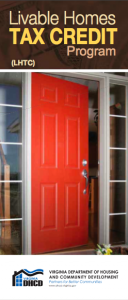There is a tax credit in Virginia called the Livable Home Tax Credit, which grants up to $5,000 to folks who purchase a new accessible housing unit, or to up to 50% of cost for folks who retrofit an existing residence with accessibility features. (The limit used to be $2,000, but was recently increased to $5,000.) Think wheel chair ramps, zero-step entrances, wide bathroom doors with space to maneuver, lower light switches and kitchen facilities, etc.
Eligibility
To be eligible for this tax credit, any purchase of new residential units with accessibility/visitability or retrofitting of such must have been made on or after January 1, 2008. Here are the guidelines:
- Eligible purchase or retrofitting expenses cannot be claimed by more than one taxpayer.
- Eligible housing units must meet the following requirements: (1) New residential units must include at least three features of the universal visitability standards, or include at least three accessibility features, (2) Existing units being retrofitted must include at least one accessibility or visitability feature.
- All accessibility and universal visitability features must be completed in conformity with the provisions of Virginia’s Uniform Statewide Building Code.
- Accessibility features that are provided in order to comply with existing Fair Housing, Equal Opportunity, Americans with Disabilities Act, or other local, state or federal requirements are not eligible for tax credits.
- Additionally, accessibility features that are funded through the Granting Freedom Program, Indoor Plumbing Rehabilitation program, Community Development Block Grant program, or other local, state, or federal programs are not eligible for tax credits.
- Costs for accessibility or visitability features must be incurred by the applicant in order to claim the tax credit.
Accessibility Features
So, what exactly are “accessibility features?” As per the eligibility requirements above, you’ll need to purchase a new residence with at least three of the below OR retrofit an existing residence with one of the below to meet the requirements of this tax credit.
- Accessible route to a zero-step entrance on a firm surface no steeper than 1:12 from a driveway or public sidewalk
- Zero-step entrance
- Doors with at least 32 inches of clear width
- Hallways and passages with at least 36 inches of clear width
- Accessible light switches, electrical outlets, and environmental controls
- Accessible bathroom
- Accessible and usable kitchen facilities
Sensory Modifications
These are things such as alarms, appliances, and controls designed to assist sensory disable persons. This type of modification must be structurally integrated into the unit and may include such items as built-in appliances.
Universal Visitability
These standards are similar to accessible housing standards and must:
- Provide at least one zero-step entrance by an accessible route on a first surface no steeper than 1:12 slope proceeding from a driveway or public sidewalk.
- Include an accessible bathroom (can be a half bath) on the same floor as the zero-step entrance.
- Include doors with at least 32 inches of clear width and hallways/passageways of at least 36 inches of clear with to the accessible bathroom and eating area.
To find out more about this tax credit, visit the Livable Home Tax Credit Program section on the Virginia Department of Housing and Community Development website.


